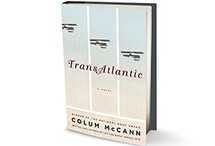9 Must-Read Books for June 2013
A century-spanning novel that makes a stop in World War I, gripping new fiction from Khaled Hosseini, revealing new details about Sylvia Plath and more.

Photo: Marko Metzinger/Studio D
1 of 9
TransAtlantic
By Colum McCann
320 pages;
Random House
On a gusty afternoon in 1919, two World War I veterans nose their plane
into the air, headed east from Newfoundland, pitching across rivers of
tailwind and blizzard before crash-landing in a bog in Ireland for the
world's first successful transatlantic flight. The navigator
furtively carries a letter, given to him by a teenage girl, in his coat
pocket. From this thrilling opening, National Book Award winner Colum
McCann weaves an intricate tapestry that illuminates the anguish of
Irish history and the deeper agonies of war. TransAtlantic
(Random House) reads as a series of interconnected novellas,
shifting between decades, among an unlikely cast of richly drawn
characters, initially foregrounding the men: aviators Brown and Alcock;
Frederick Douglass, seeking support from Irish abolitionists on the eve
of the potato famine; Senator George Mitchell, brokering a tenuous peace
between Catholics and Protestants. But McCann's narrative truly
soars when he brings in four generations of Irish women—Lily,
Emily, Lottie and Hannah. As he fleshes out their hopes and horrors,
TransAtlantic gains altitude and velocity, its
stories lifting and intersecting, the unopened correspondence a talisman
passed from one generation to the next. At its heart the novel is
profoundly antiwar, shaking its fist at needless bloodshed.
"When you get up to sit with God or the devil you can curse them
both for me," Lily muses to the corpse of her slaughtered son.
"This god-awful manufacture of blood and bone. This fool-soaked
war that makes a loneliness of mothers." Reminiscent of the
finest work of Michael Ondaatje and Michael Cunningham,
TransAtlantic is Colum McCann's most
penetrating novel yet.
— Hamilton Cain
Published 05/29/2013


